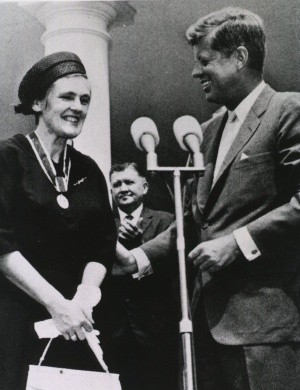Kefauver-Harris Amendment
From Rx-wiki
Contents
Thalidomide disaster and Francis Kelsey
Francis Kelsey, Ph.D., was hired to work for the FDA in 1960 and the first drug she was asked to review for approval was thalidomide. Back in the 1940s Dr. Kelsey had been doing research to try and find a synthetic cure for malaria. While not discovering a cure, she did notice that some of the drugs they were studying actually crossed the placenta. Considering that thalidomide was being used in pregnant women as an antiemetic she wanted to see more research done on this possibility with respect to thalidomide before she would approve it. Grünenthal was not happy with her resistance to approving the medication, but she was vindicated when children being born with birth defects were linked back to the use of thalidomide. From 1956 to 1962, approximately 10,000 children were born with severe malformities, including phocomelia, because their mothers had taken thalidomide during pregnancy.
As a result of her blocking FDA approval of thalidomide in the United States, Kelsey was honored the President's Award for Distinguished Federal Civilian Service by President John F. Kennedy, becoming the second woman to receive that award.
After receiving the award, Kelsey continued her work at the FDA. There she played a key role in shaping and enforcing the 1962 Amendments. She also became responsible for directing the surveillance of drug testing at the FDA. Kelsey finally retired from the FDA in 2005, at age 90, after 45 years of service.
What this amendment accomplished
Among other things, the amendment requires drug manufacturers to show the effectiveness of their products as well as their safety, to report adverse events to the FDA, and to ensure that their advertisements to physicians disclose the risks as well as the benefits of their products. Informed consent was required from participants in clinical studies. The FDA also was given jurisdiction over prescription drug advertising. In addition, the agency was required to approve a regulatory submission known as a new drug application before a company could market a new drug and be allowed to issue good manufacturing practice guidelines governing how drugs were to be manufactured. Inspection of drug manufacturers was mandated every 2 years.
The law was signed by President John F. Kennedy on October 10, 1962.
The Kefauver-Harris Amendment provided the modern scenario for approving new drugs:
- Initial drug discovery.
- Preclinical (animal) testing.
- An investigational new drug application (IND) outlines what the sponsor of a new drug proposes for human testing in clinical trials.
- Phase 1 studies (typically involves 20 to 100 healthy people).
- Phase 2 studies (typically involves 100 to 500 people with the ailment that the new drug is intended to treat).
- Phase 3 studies (typically involves 1,000 to 5,000 people with the ailment that the new drug is intended to treat).
- The pre-NDA period, just before a new drug application (NDA) is submitted. A common time for the FDA and drug sponsors to meet.
- Submission of an NDA is the formal step asking the FDA to consider a drug for marketing approval.
- After an NDA is received, the FDA has 60 days to decide whether to file it so it can be reviewed.
- If the FDA files the NDA, an FDA review team is assigned to evaluate the sponsor's research on the drug's safety and effectiveness. This review may take from 6 months to 2 years.
- The FDA reviews information that goes on a drug's professional labeling (information on how to use the drug).
- The FDA inspects the facilities where the drug will be manufactured as part of the approval process.
- FDA reviewers will approve the application or find it either "approvable" or "not approvable."
- Post marketing study commitments, also called Phase 4 commitments.
See also
Federal pharmacy law
Food, Drug, and Cosmetic Act
Food and Drug Administration
References
- Pharmacy Times, A Review of Federal Legislation Affecting Pharmacy Practice, Virgil Van Dusen , RPh, JD and Alan R. Spies , RPh, MBA, JD, PhD, https://secure.pharmacytimes.com/lessons/200612-01.asp
- Strauss's Federal Drug Laws and Examination Review, Fifth Edition (revised), Steven Strauss, CRC Press, 2000
- Food and Drug Administration, Legislation, http://www.fda.gov/RegulatoryInformation/Legislation/default.htm
- Food and Drug Administration, History, http://www.fda.gov/AboutFDA/WhatWeDo/History/default.htm
- Wikipedia, Kefauver-Harris Amendment, http://en.wikipedia.org/wiki/Kefauver_Harris_Amendment
- Food and Drug Administration, The FDA's Drug Review Process: Ensuring Drugs Are Safe and Effective, http://www.fda.gov/drugs/resourcesforyou/consumers/ucm143534.htm
- Wikipedia, Frances Oldham Kelsey, http://en.wikipedia.org/wiki/Frances_Oldham_Kelsey
- Wikipedia, Thalidomide, http://en.wikipedia.org/wiki/Thalidomide
- New York Times,Answers Begin to Emerge on How Thalidomide Caused Defects, Carl Zimmer, March 15, 2010, http://www.nytimes.com/2010/03/16/science/16limb.html?ref=science&pagewanted=all

